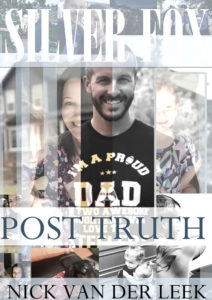One critical component is missing from the Watts Family Murders. It’s this missing link that makes the crime atypical, and Watts himself such an enigma. Intertextuality provides us with some clues to what fits the criminal psychology, and what doesn’t.
The Manrique Family Tragedy played out in a suburb of Sydney, Australia on Monday, October 17, 2016:
A Sydney father who is suspected of pumping lethal amounts of carbon monoxide into his home as the family slept resulting in the deaths of his wife and two children, made multiple trips to a Bunnings store before the deaths, an inquest has heard.
In the days leading up to family’s deaths, Fernando Manrique, 44, visited the store in Belrose in Sydney’s north shore to buy equipment that police believe was used to set up an elaborate mechanism to channel the deadly gas from a garden shed, through the roof and into the house.
Manrique, his wife Maria Lutz, 43, and their two children, Elisa and Martin, were found dead inside their family home on Monday, October 17, 2016.The inquest into the four deaths, which began today, also heard Manrique had been having an affair with a teenager he met in a bar in the Philippines.
Superficially we see more than a few consistencies:
- The murders [and suicide] were carefully planned – that is premeditated – over a few days prior to tragedy.
- The premeditation wasn’t simple.
- The father was having an affair while married, and in spite of being a father to two small children [aged 11 and 12]
But between the parallels there are a few inconsistencies too:
Maria had not been replying to text messages the weekend before and hadn’t dropped her kids at school on the Monday morning. On the morning of October 17, police conducted a welfare check at the home after Ms Lutz’s friend Nichole Brimble noticed the devoted mother had failed to turn up to her volunteer shift at the school canteen, and learnt the children were not at school. Police attended the single-storey home in the leafy northern beaches suburb of Davidson. While officers initially thought nothing was amiss, they soon made the grim discovery of Maria’s body through an open window.
Her daughter Elisa, 12, was beside her in bed, her husband was slumped in a hall while 11-year-old Martin’s body was found in another bedroom. The family dog, Tequila, was also dead lying on the floor close to Martin.
Asked if there was evidence to suggest Maria had a role in her children’s deaths, he said: “She wasn’t involved at all or had any knowledge. Going through phone records no indication with any person of anything like that.” Counsel assisting Adam Casselden said it was likely the family died sometime between 11am on the Sunday and 11am on the Monday, most likely as the mother and her two children slept in the early hours of Monday morning.
A neighbour said they distinctly remembered the barking of a dog from the house at 2.30am.
The couple were childhood sweethearts from their home in Bogota, Colombia. They emigrated to Australia and gave birth to their daughter in 2005 and son in 2006. Both were diagnosed with autism. “Caring for Martin and Elisa was no doubt challenging,” Mr Casselden said. Despite the challenges the care of the children posed, Judge Truscott said there was no indication Maria was involved in her children’s deaths.The inquest heard that, initial speculation that Ms Lutz was aware of Mr Manrique’s fatal plan, would be dispelled by the steps he took to hide it from her, and because of her happiness at securing $50,000 in government funding to help with the care of Elisa and Martin. Ms Truscott said it was clear from the evidence of Ms Lutz’s large network of friends that “Maria loved her life, loved her children and had every intention of continuing a very loving, giving and productive life with her children”.
Indeed, he said the relationship between Maria and Manrique had broken down. “There was very little conversationwith her husband and with conversations with friends she said she has ‘had enough of him’,” Det Sgt Pooley said.
Maria, who used to be a lawyer in Colombia, had given up work to care for her children while her husband had been made redundant. That had seen his income fall dramatically as he helped set up another company, which led him to frequently visit the Philippines. Detective Sergeant Pooley said the couple had just $6 in a family trust, had credit card debts of $28,000, only a few thousand dollars in a savings account and two mortgages, which Manrique had reduced his repayment amounts on.
“I’d say that he was in dire straits and had massive tax issues,” the detective said. Mr Casselden said the couple had a debt to the Australian Tax Office of about $15,000 in September 2016. Despite this, shortly before the family died Manrique wired several thousand dollars to a lover in the Philippines that he met while travelling for work. Mr Casselden said Manrique had met a 17-year-old called Jamielyn in a bar in the Philippines in 2016.
“He confided in a friend his marriage had become strained and he was seeing other women in the Philippines,” he said. Manrique would “hook up” with other women and had been seeing Jamielyn for at least four months on his trip abroad prior to the family’s deaths. (Manrique) said he would buy her a property but never did so. She recalled that he was particularly stressed on a final trip in September 2016.”
“Manrique told [his business partner] Mr McKenzie that he was struggling to hold everything together and said ‘I just need to slow down’,” Mr Casselden said. In the weeks before the family’s deaths, Manrique had left the Davidson home but had returned in early September for a temporary period, he told his wife, while he found somewhere else to live.
Usually distant, Manrique seemed to be a changed man. Maria confided in a friend that “if he had been like this throughout the marriage, I would never have told him to go”.
“Maria described him as ‘father of the year’ during that week,” Mr Casselden said.
The biggest difference?
More: ‘A horrific thing’: the death of the Manrique-Lutz family – Sydney Morning Herald











I was reading this article yesterday here in Australia and was wondering if Nick would find this story and the similarities to the Watts family. Initially, investigators wondered if he’d taken them all out because of the children’s disabilities, (non-verbal autism) and how difficult life was for them. To hear the horrific truth come out, it drew comparisons to CW immediately for me…. the financial mess, the affair..
The difference? He took himself out too.
This anomaly is evident in this article I found and in differences I’ve noticed between other annihilators who don’t suicide and Watts (like Robert Fisher.) This article shows what I mean-
“Gelles estimates that around 90% of these intimate homicides include patterns of controlling violence and patterns of domestic abuse, abuse in which one partner seeks to control the other, and says those abusive behaviors can ultimately escalate into homicidal acts. Family annihilators may or may not exhibit similar tendencies and behaviors, but this much smaller number of intimate murders is precipitated by a specific event.
“That is not so much control, as shame,” says Gelles. “These guys have somehow come into some shameful event, economically or socially. They want to kill themselves, but they’re so enmeshed in their family system, they choose to take their whole family with them. And those are the cases where the neighbors, when they’re interviewed, say ‘Boy, I’m totally amazed and surprised, I mean, he was a nice, quiet guy. He was the last person in the world I would expect to do it.’”
This is different from murder, non-suicides. In such cases, Gelles says, there is usually a track record — and possibly a police record — of child abuse or domestic violence.”
So obviously Watts had no violent past and everyone did say all those things about him-yet he was not ever going to commit suicide (the gas can was always a red herring IMO.) But I do believe that there was a triggering event and had shame at its root-but if there’s family enmenshment it seems to be with his family of origin. He had no suicidal ideation whatsoever. I try to find the most similar case and it’s a struggle.
I think the Chris Coleman case comes pretty close. Coleman never intended to kill himself, either; like Watts, he had a girlfriend on the side, and wanted to be with her. The cases are not exactly parallel, (for instance, Coleman’s wife was not pregnant at the time of the murders, and their children were quite a bit older than the little Watts girls), but in many ways, the similarities are astonishing. Both men are now in the same prison, Interestingly.
Great post! Very interesting.
The biggest differences to me are the method of annihilation and provable premeditation. Watts’ case initially reads like a rage killing – especially considering that he manually strangled all of them. But it doesn’t stay within those confines easily (lack of escalation, lack of struggle, two tanks for two kids, securable alibi, etc). The Watts’ case begs a question: are there clear signs that he premeditated these murders? What is the difference between rage killing Shan’ann and then killing the kids after that “rage” has passed? How does murder progress from rage to premeditated? Can a murder spree change motives during the actual murders? And the can the change in method, location, or motive behind those murder better outline the original motive? For example, rage killing Shan’ann may not fully explain the murder of the children.
But what the Aus case reveals is that Chris might not have premeditated as much as we think he did. And as he tells us in his second confession he was absolutely in a murderous psychotic rage that morning and his dumping site was purely off-the-cuff. And he went from father to murderer to serial killer to calm corpse dumper in a matter of hours which is something no sane person could do. So is premeditation even necessary for someone so cold? In other words, if you can become psychotic then premeditation isn’t a matter of if it’s a matter of when. That premeditation might have been in him for YEARS, he just pulled the trigger that night like flipping a switch, no preparation necessary.
I also wondered what you thought about something: bedding. These are the major questions I have a) why was there no stain of evacuated bowels on the fitted sheet or mattress in the Watts’ master? b) why was she wrapped in the downstairs sheet? c) what sheet was left to tumble in the wind? d) what sheet was wrapped around her in the shallow grave?
Thank you! Enjoy this site so much.
“he manually strangled all of them”
Is there any evidence that the little girls were *strangled*? My understanding is that the evidence is consistent with Chris drugging them (probably using Shan’Ann’s extra Oxycodone) and then smothering them (possibly with a plastic bag around the head).
A because she wasn’t killed on the bed or anywhere near the fitted sheet.
B she was wrapped in one of the sheets that Chris watts had gotten from the master bed, to transport in. The other sheet and pillow cases were used (it seems) to wipe up some form of mess, likely her bodily fluids after death. Some say makeup but I believe it was never tested and confirmed. These were dumped in the kitchen trash bin
C the sheet left to tumble in the wind was the one CW wrapped her in at home to transport her in
D she wasn’t wrapped in any sheet in the grave. The sheet we see LE bag and then hold up at the police station was a sheet the coroner brings and always uses to lay bodies on at the site they are found.
I agree with Sarah’s thoughts about motivation possibly changing during a set of social circumstances and events.
Fernando Manrique set up the pipes carrying the gas from the shed to the roof space during the day while his wife, Maria, was volunteering at the children’s school.
Otherwise she may have questioned what he was doing up on the roof: his activities, and all that banging, were seen and heard by the neighbours. It’s a pity that they did not mention this to her. My neighbours want to know what’s being done in a house the minute they see a workman’s van in anyone’s drive, and they like to inspect others’ DIY work. She maybe did not notice that he had put a new padlock on the shed door. Fancy picking the lock and finding the canisters there.
Then there are his friends who innocently took delivery of the carbon monoxide canisters from the firm. The latter is going to revise its protocol for delivering this sort of thing to non-commercial addresses.
Dr Nitschke first of all thought that Fernando had been in touch with the voluntary euthanasia society, but later apologised saying he had confused the Christian names, it was another person who had sought information. He wondered at the method used, as Bogota in Colombia is one of the few places where pentobarbital can be bought.
However, I think that at least Maria and the children were not aware of what happened to them as they slept. The dog probably sensed something so barked, but this alarm was unheeded, maybe it was too late.
Some think that Fernando might have been trying to run away, but was overcome by the gas, nobody knows. It’s really sad, and I don’t know why he destroyed his computer hard disk by fire first.
Sentencing hearing of another australian family murderer
https://www.abc.net.au/news/2019-06-21/bedford-mass-murderer-anthony-harvey-sentencing-hearing/11231044